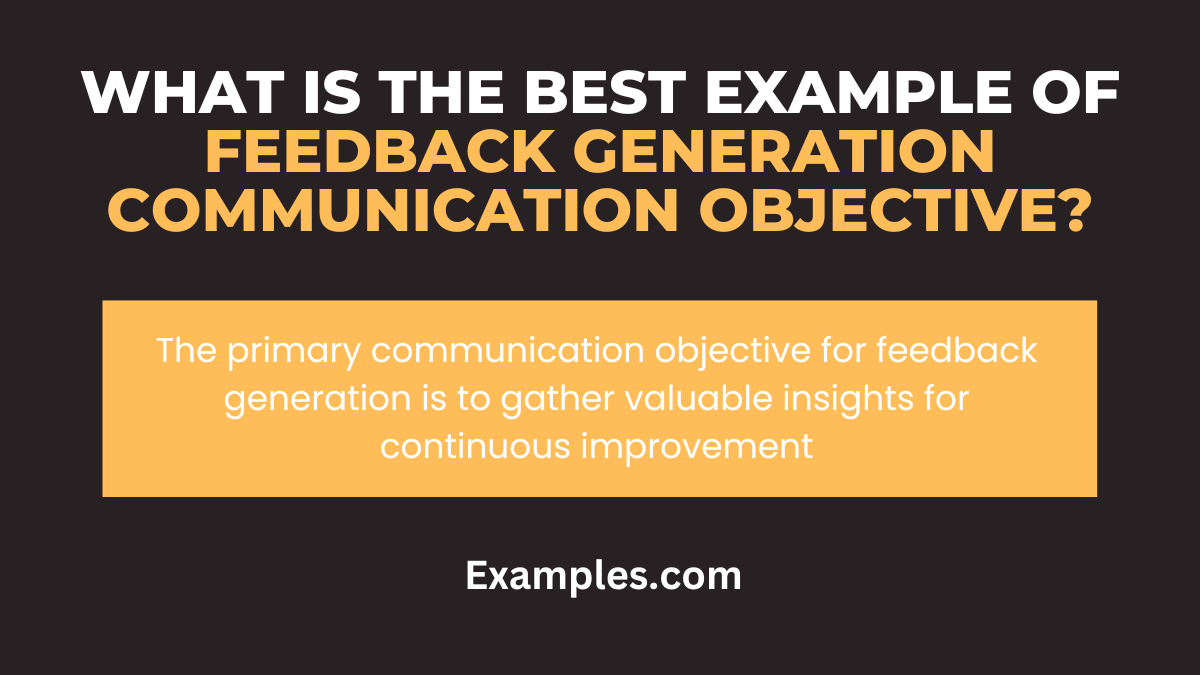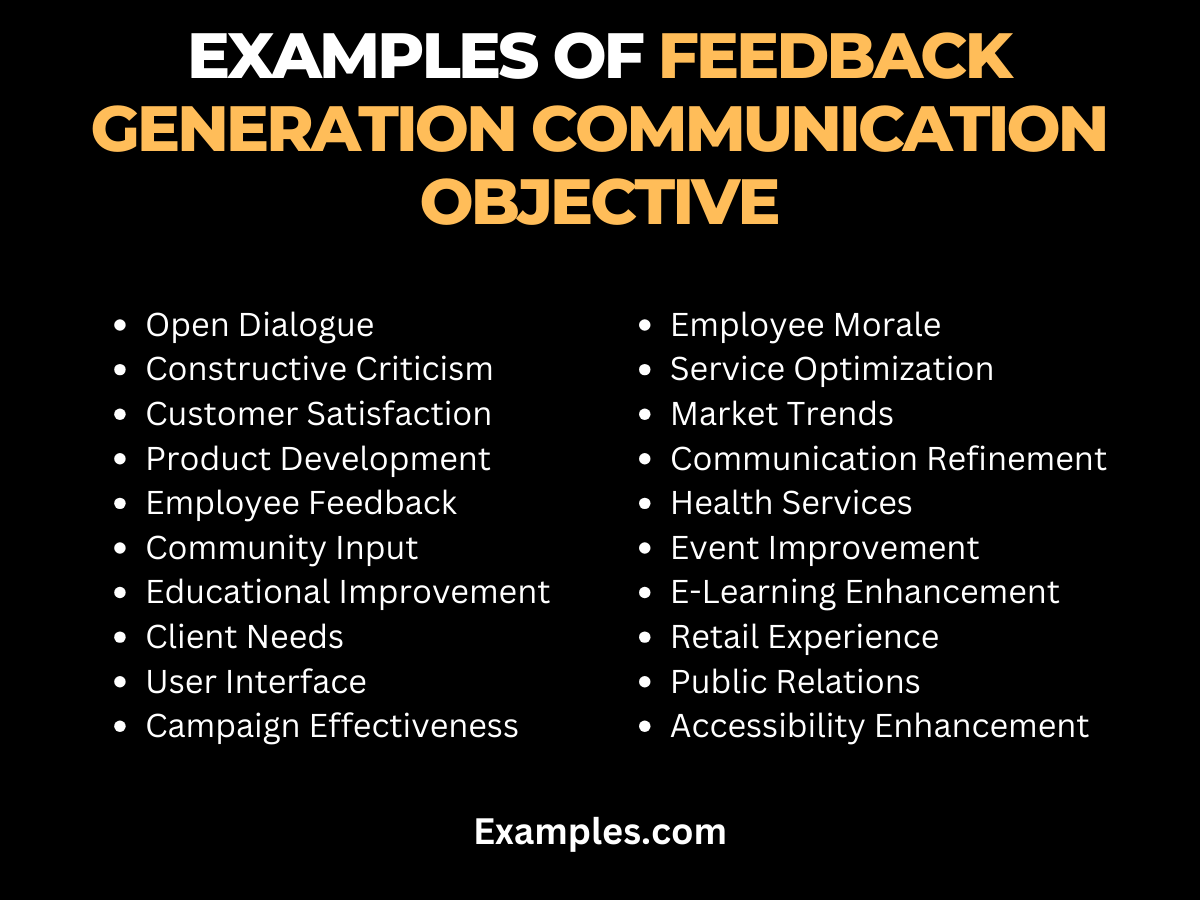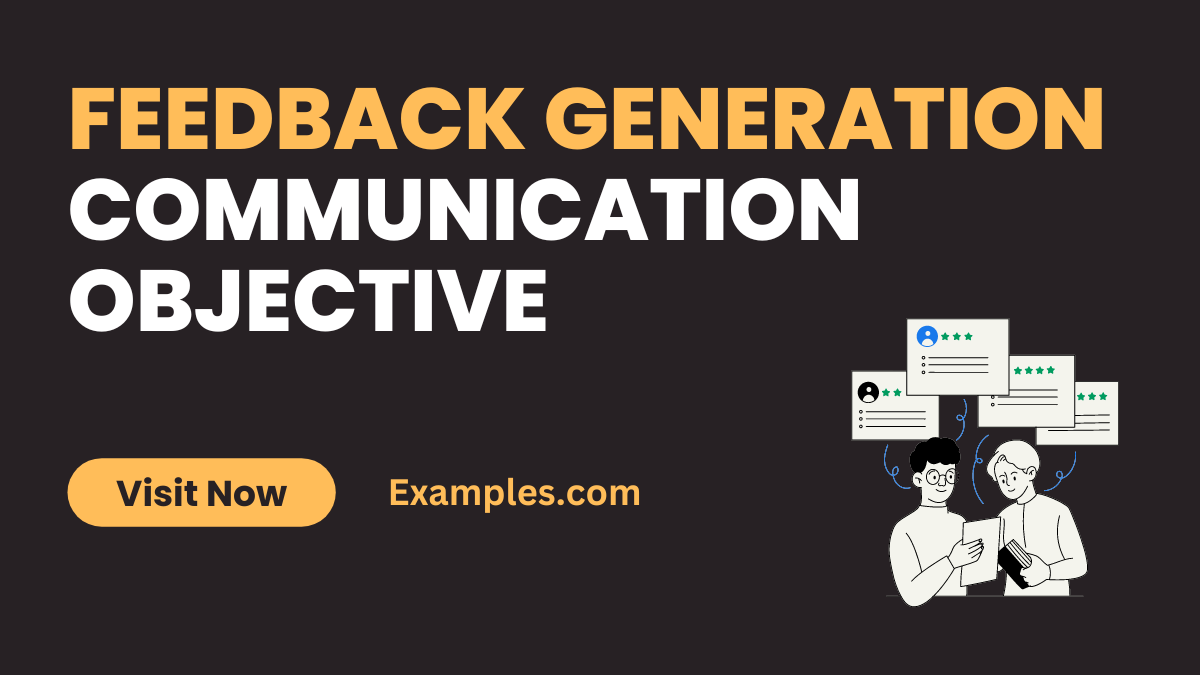19+ Feedback Generation Communication Objective Examples
In today’s dynamic communication landscape, mastering the Feedback Generation Communication Objective is crucial. This guide delves into the essence of creating impactful feedback strategies that resonate with audiences. It addresses the art of crafting feedback that is not only informative but also engaging and transformational. Perfect for professionals and individuals alike, this guide is your go-to resource for elevating your feedback skills, enriched with practical tips and insights.
What is the Feedback Generation Communication Objective?

The Feedback Generation Communication Objective revolves around developing strategies to elicit constructive feedback from audiences. It’s a critical component in effective communication, aiming to gather insights, opinions, and reactions that inform and guide future interactions and decisions. This objective is fundamental in various fields, from business to education, enhancing the quality and effectiveness of communication.
What is the Best Example of Feedback Generation Communication Objective?

A prime example of the Feedback Generation Communication Objective is a company seeking customer feedback on a new product. They employ various communication channels like surveys, focus groups, and social media to gather honest opinions. This feedback not only helps in refining the product but also strengthens customer relationships by showing that their opinions are valued and considered.
20 Examples of Feedback Generation Communication Objective

Feedback generation in communication is essential for understanding audience responses, enhancing services, and improving strategies. Effective feedback communication objectives involve clarity, empathy, and an openness to learn and adapt. Here are 20 examples, each with a brief explanation and example sentences on how to communicate these objectives:
- Encourage Open Dialogue: Create an environment where feedback is welcomed and valued.
Example: “We value your thoughts and are eager to hear your honest opinions.” - Seek Constructive Criticism: Aim to receive actionable suggestions.
Example: “Please let us know how we can improve our services.” - Gather Customer Satisfaction Data: Understand customer experiences for service improvement. Example: “Your feedback helps us serve you better. How was your experience with us?”
- Enhance Product Development: Use feedback to refine products.
Example: “What features would you like to see in our next update?” - Facilitate Employee Reviews: Obtain feedback for employee development.
Example: “We would appreciate your input on how our team performed.” - Collect Community Input: Engage the community for relevant changes.
Example: “Your suggestions can help shape our community programs. What are your thoughts?” - Improve Educational Content: Request feedback from learners to upgrade teaching methods.
Example: “How can we make our lessons more engaging and informative for you?” - Assess Client Needs: Tailor services to client preferences.
Example: “What specific needs do you have that we can address better?” - Strengthen User Interface Design: Solicit opinions on app or website usability.
Example: “How user-friendly do you find our new app interface?” - Measure Campaign Effectiveness: Evaluate the impact of marketing strategies.
Example: “Could you share how our recent campaign resonated with you?” - Boost Employee Morale: Get feedback to motivate and acknowledge staff.
Example: “What can we do to make your work experience more fulfilling?” - Optimize Customer Service: Enhance support based on user feedback.
Example: “In what ways can our customer service team better assist you?” - Identify Market Trends: Stay ahead by understanding customer preferences.
Example: “What trends are you currently interested in our industry?” - Refine Communication Strategies: Adjust messaging for better audience reception.
Example: “Is our communication clear and relevant to your needs?” - Develop Health Services: Adapt healthcare based on patient feedback.
Example: “How can we improve your experience at our clinic?” - Improve Event Planning: Use feedback for organizing successful events.
Example: “What did you enjoy about our event, and what could be better?” - Enhance Online Learning Platforms: Adjust e-learning tools based on user experience.
Example: “What features do you find most useful in our online platform?” - Optimize Retail Experience: Tailor retail strategies to customer preferences.
Example: “What can make your shopping experience with us more enjoyable?” - Strengthen Public Relations: Adjust PR tactics based on public feedback.
Example: “How do you perceive our efforts in community engagement?” - Enhance Accessibility Services: Make services more inclusive with user suggestions.
Example: “What can we do to make our services more accessible to you?”
What is the Purpose of Giving Feedback During Communication?
- Enhances Understanding: Feedback helps clarify misunderstandings, ensuring both parties are on the same page.
- Promotes Learning: It provides an opportunity for learning and growth, highlighting areas for improvement.
- Facilitates Better Decision Making: Constructive feedback contributes to informed decision-making processes.
- Boosts Engagement: When feedback is given, it creates a two-way conversation, enhancing engagement.
- Encourages Positive Behavior: Positive feedback reinforces desired behaviors and outcomes.
- Builds Trust and Transparency: Honest feedback fosters a culture of trust and openness in communication.
Importance of Feedback Generation Communication Objective
- Objective Assessment: Feedback offers an objective perspective, helping individuals understand how their actions are perceived.
- Continuous Improvement: It encourages continuous personal and professional development.
- Strengthened Relationships: Regular feedback strengthens relationships through consistent and open communication.
- Aligns Expectations: Helps in aligning expectations and objectives between communicators.
- Promotes a Culture of Accountability: Feedback generation instills a sense of responsibility and accountability.
- Enhances Team Dynamics: Regular feedback can significantly improve team collaboration and dynamics.
Positive Feedback Generation Communication Objective
- Reinforces Good Practices: Acknowledges and reinforces effective behaviors and practices.
- Boosts Morale: Increases motivation and morale by recognizing achievements.
- Encourages Repeat Performance: Positive feedback encourages repetition of good performance.
- Strengthens Relationships: Builds stronger connections through positive reinforcement.
- Increases Engagement and Productivity: Positive feedback has been linked to higher engagement and productivity.
- Builds Confidence: Enhances self-esteem and confidence in abilities.
Constructive Feedback Generation Communication Objective
- Identifies Areas for Improvement: Highlights specific areas needing improvement without personal criticism.
- Facilitates Professional Growth: Offers guidance for professional development and skill enhancement.
- Encourages Open Dialogue: Promotes a culture where feedback is shared openly and respectfully.
- Improves Performance: Targets specific behaviors or skills for improvement, enhancing overall performance.
- Builds Problem-Solving Skills: Encourages individuals to develop solutions for identified issues.
- Fosters Adaptability: Helps individuals learn to adapt to changing requirements or standards.
Effective communication is vital for generating feedback. To improve communication, follow these tips: be clear, listen actively, and be respectful. Use simple language and avoid barriers like fear or insecurity. By doing so, you’ll foster better feedback generation and communication success.



